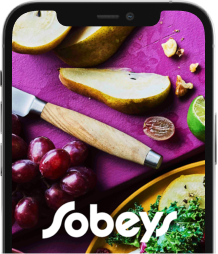Tasty, versatile and good for both you and your wallet, pulses have got a lot going for them. From lentils to chickpeas to beans, the legume family is grown extensively in the Canadian Prairies and can be found at the heart of diverse cuisines. It’s time for you to get soaking!
What Are Pulses?
There are an astonishing 13,000 species of legumes—plants that grow pods with fruits inside, such as peas, soybeans and peanuts. The edible seeds of leguminous plants are referred to as pulses.
Pulses come in many shapes, sizes and colours, but the most common ones are lentils, chickpeas, beans and peas.
You can buy pulses whole, split or finely ground into flours. Sometimes they’re even broken down into proteins, fibre and starches. The proteins can be found in non-dairy milks, nutrition bars and vegetarian prepared foods, while the starches are often an ingredient in cereals, noodles and thickeners. The ground fibre is most often used in baked goods, cereals and drinks.
Pulse crops love Canadian soils and our long, sunny summer days. Our cold winters also protect them from disease and insects while they’re in storage. Canada is the world’s leading exporter of lentils and peas, and one of the top five exporters of beans, selling to more than 150 different countries. Saskatchewan is our pulse-growing epicentre.
Fun fact: The word “pulse” has its roots in the Latin term puls, meaning “thick soup.”
Pulses: A Nutritional Powerhouse
These tiny little things pack a nutritional punch!
Canada’s Food Guide recommends eating meat alternatives such as beans, lentils and tofu often. One cup (250 mL) of cooked black beans, for instance, contains 16 g of protein, 1 gram of fat and 8 grams of fibre. This same serving of black beans also delivers 48 mg of calcium and 256 mcg of folate, an essential nutrient typically associated with leafy greens.
What’s more, recent studies seem to suggest that a healthy diet that includes pulses may help reduce levels of LDL cholesterol (the “bad” cholesterol that contributes to clogged arteries).
Preparing Pulses
When cooked from their dried form (as opposed to canned), most pulses are presoaked to reduce cooking time. For every cup (250 mL) of dry pulses, use three cups (750 mL) of cold tap water for soaking. After 12 hours or overnight, discard the soaking liquid and run fresh tap water over the pulses in a sieve or strainer.
Smaller pulses, such as lentils, split peas and black beans, don’t need a long soak. A good rinse will do before cooking.
Before soaking large beans or rinsing smaller pulses, sort through them to remove any shrivelled or broken ones, plus any tiny stones that may have been collected during harvest.
To Soak or Not to Soak
There’s controversy in the pulse-cooking world: Some prefer to skip the soaking stage in favour of a slightly longer cooking time, claiming this method results in better overall flavour without a negative effect on digestion. Whichever method you choose, always check water levels and test for doneness throughout the cooking process, as your pulses might be ready in less or more time than guidelines recommend.
Cooking Pulses
Cooking times will vary, depending on the size, age and quality of the pulses you’re using. (In general, the longer they’ve been in storage, the longer you’ll need to cook them—and very old beans may never soften up.)
Expect it to take one to three hours for larger pulses such as chickpeas and lima beans, and as little as 10 minutes for red lentils. Consult our handy chart for cooking times and multiple methods. If you notice the liquid level is getting low while your pulses are simmering, just add more water. When simmering chickpeas for hummus, add a little baking soda to the cooking water for a smoother dip.
Keep cooked pulses and dishes containing them at room temperature for no more than two hours. Store cooked pulses covered in the fridge for up to three days and in sealed containers in the freezer for up to several months. Make sure reheated leftovers reach an internal temperature of 165˚F (74˚C).
Tip: Boost the flavour of your beans by adding salt, peppercorns, bay leaves, garlic, onions, and other herbs and spices to the cooking liquid.
To Salt or Not to Salt
Many experts recommend avoiding salt in both the soaking and cooking water for softer, more evenly cooked beans, while newer methods indicate salt tenderizes the skin and results in a creamier interior. Try either method on a small batch to determine if the resulting texture is right for you.
Dried vs. Canned
Here’s a rough estimate of how many dried beans you’ll need for a recipe that calls for canned and vice versa.
| Dried | Cooked | Canned |
| 2/3 cup (150 mL) dried beans | 2 cups (500 mL) cooked beans | 1 (540 mL/19 oz) can beans |
Tip: Freezing cooked beans in quantities equivalent to standard cans will save you time later on. For example, store cooked chickpeas in 2-cup (500 mL) portions to whip up our Classic Hummus whenever the mood strikes.
Buying and Storing Pulses
Buy dried pulses in small quantities, and store them in a cool, dark place in sealed containers to prevent spoilage and to keep out pulse-loving insects. Refer to the expiration date on the packaging, but as a general rule, it’s best to use them up within one year of opening.
How to Enjoy Pulses
Peckish? Nibble on raw vegetables or warm pita strips dipped in Zesty White Bean Dip. Or try Baked Falafel Snack Bites, which are packed with black beans and quinoa.
Cooked with an array of root vegetables, Braised Navy Beans turn butter soft in the oven and make a complete vegetarian dinner when served with rice or bread.
For an all-Canadian meal, tuck into Maple-Bacon Slow Cooker Beans—they’re perfect reheated over a campfire or savoured with the family at home on a cold winter’s night.
Lasagna is a family dinner favourite. Made with whole wheat noodles, Beef, Lentil and Squash Lasagna is extra wholesome.
Warm up with a hearty bowl of Spicy Eggplant & Beef Chili made with jalapeño peppers and lots of chunky vegetables.
Feed a crowd with our Big Batch Split Pea Soup—the perfect recipe for using up leftover holiday ham.
For an easy meal, you can’t beat our Red Lentil & Tomato Soup made with lots of carrots, celery, canned diced tomatoes and easy-to-cook red lentils.




